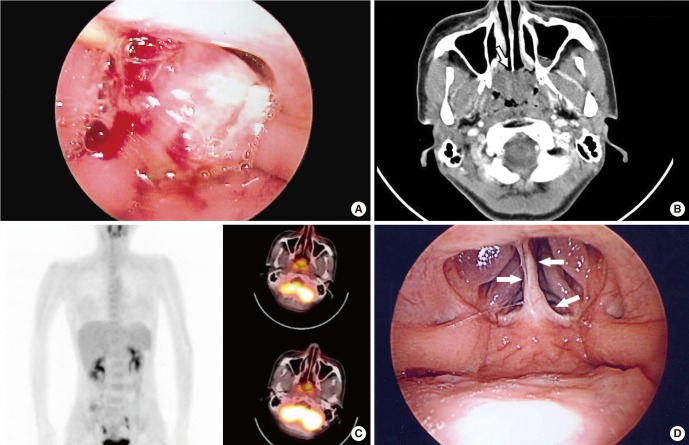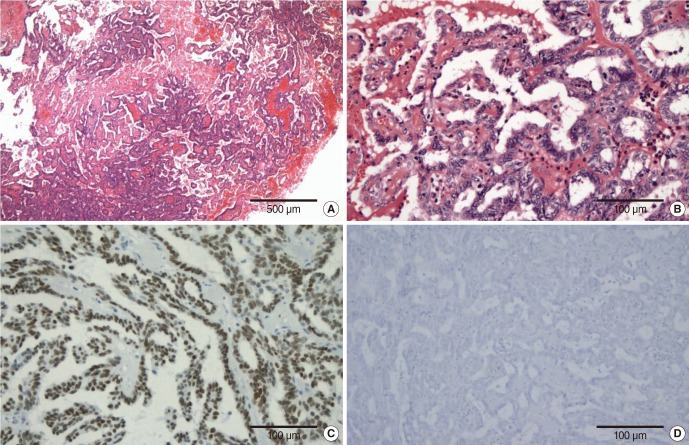Clin Exp Otorhinolaryngol.
2013 Mar;6(1):48-51.
Exclusive Endoscopic Resection of Nasopharyngeal Papillary Adenocarcinoma via Combined Transnasal and Transoral Approach
- Affiliations
-
- 1Head and Neck Oncology Clinic, Center for Specific Organs Cancer, Center for Thyroid Cancer, National Cancer Center, Goyang, Korea. jysorl@ncc.re.kr
- 2Department of Pathology and Division of Specific Organs Cancer, Research Institute and Hospital, National Cancer Center, Goyang, Korea.
Abstract
- Low grade nasopharyngeal papillary adenocarcinoma (LGNPPA) is an extremely rare variant of nasopharyngeal cancer, which exhibits distinct clinicopathological characteristics. Surgical resection has been regarded as the principal treatment. For this, transpalatal or transfacial approach has been classically used for exposure of the field. Up for now, there has been no report on applying endoscopic approach for this disease, which could be an effective alternative to minimize possible morbidities of palatotomy or maxillotomy. Endoscopic approach can be justified considering narrow extent and indolent behavior of LGNPPA. We report a patient with LGNPPA, which was successfully resected exclusively by endoscopic visualization. Our case exhibited narrow-based exophytic features with compatible immunopathologic profiles of LGNPPA. Exclusive endoscopic resection can be effective and less-morbid modality for this rare disease as in this case.
MeSH Terms
Figure
Reference
-
1. Wenig BM, Hyams VJ, Heffner DK. Nasopharyngeal papillary adenocarcinoma: a clinicopathologic study of a low-grade carcinoma. Am J Surg Pathol. 1988; 12. 12(12):946–953. PMID: 2462370.2. van Hasselt CA, Ng HK. Papillary adenocarcinoma of the nasopharynx. J Laryngol Otol. 1991; 10. 105(10):853–854. PMID: 1753201.
Article3. Nojeg MM, Jalaludin MA, Jayalakshmi P. Papillary adenocarcinoma of the nasopharynx: case report and review of the literature. Med J Malaysia. 1998; 3. 53(1):104–106. PMID: 10968147.4. Wang CP, Chang YL, Chen CT, Yang TH, Lou PJ. Photodynamic therapy with topical 5-aminolevulinic acid as a post-operative adjuvant therapy for an incompletely resected primary nasopharyngeal papillary adenocarcinoma: a case report. Lasers Surg Med. 2006; 6. 38(5):435–438. PMID: 16470845.
Article
- Full Text Links
- Actions
-
Cited
- CITED
-
- Close
- Share
- Similar articles
-
- Exclusively Endoscopic Resection of Nasopharyngeal Adenocarcinoma
- Transnasal Endoscopic Resection of Juvenile Nasopharyngeal Angiofibroma: A Case Report
- A Case of Nasopharyngeal Papillary Adenocarcinoma: Nasal Endoscopic Approach
- Transoral Adenoidectomy with the Microdebrider under Transnasal Endoscopy
- A Case of Low-grade Papillary Adenocarcinoma of the Nasopharynx



